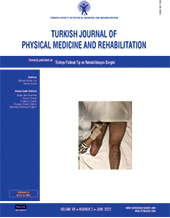Urinary system complications and long-term treatment compliance in chronic traumatic spinal cord injury patients with neurogenic lower urinary tract dysfunction
2 Department of Physical Medicine and Rehabilitation, Istanbul Physical Medicine and Rehabilitation Training and Research Hospital, Istanbul, Turkey DOI : 10.5606/tftrd.2022.7719 Objectives: The aim of this study was to evaluate upper and lower urinary tract complications and the compliance of long-term treatment in patients with spinal cord injury (SCI) by urodynamic examination.
Patients and methods: Between January 1997 and May 2007, a total of 89 patients with SCI (79 males, 19 females; mean age: 39.8±12.2 years; range, 19 to 72 years) who were admitted to physical medicine and rehabilitation clinic were retrospectively analyzed. Demographic, neurological, and urodynamic data of the patients with the diagnosis of neurogenic lower urinary tract dysfunction (NLUTD) in their initial urodynamic examination and without regular follow-up were recorded.
Results: The mean time to the first urodynamic examination was 8.6±5.4 months. Sixty-seven patients who had neurogenic detrusor overactivity (NDO) in their first urodynamic tests were recommended anticholinergics. Clean intermittent catheterization (CIC) was recommended after initial urodynamic examination in all patients. Thirty-nine patients of 67 who had NDO were taking medications, while 28 were not. In the patients who continued anticholinergic treatment, bladder capacity was found to statistically significantly increase, compared to the initial measurement values and detrusor pressures significantly decreased (p<0.001). The compliance rate with CIC and anticholinergic treatment was 79.8% and 58.2%, respectively. Sixteen of the patients had calculus in the urinary system. Forty-two patients had infections more than once a year and used antibiotics.
Conclusion: Neurogenic bladder should be evaluated at the beginning of SCI and, then, followed on a regular basis. Urodynamic tests should be performed immediately after spinal shock and can be repeated, as indicated.
Keywords : Neurogenic bladder, spinal cord injury, urinary incontinence, urodynamics

















